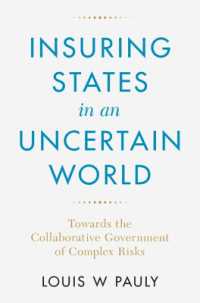- ホーム
- > 洋書
- > 英文書
- > Architecture
Full Description
Open Building is an internationally recognized approach to the design of buildings and building complexes with roots in the way the ordinary built environment grows and regenerates. The Open Building approach recognizes that both stability and change are realities to be managed in the contemporary built environment. Buildings - and the neighborhoods they occupy - are not static during the most stable times or during times of rapid social and technical change. They are living organisms that need constant adjustments to remain attractive, safe and valuable.
Using case studies of built projects from around the world, this book explains the Open Building approach and discusses important characteristics of everyday built environment that the Open Building approach designs for. It also presents a key method that can be used to put the approach into use. It addresses questions such as:
How can we design large projects for inevitable change?
How can we balance the demands of large projects for efficient implementation with the need for 'fine-grained' decision-making control?
How can we separate design tasks, one task being the design of what should last a century, the other task being the design of more mutable units of occupancy?
How can we identify and share architectural themes and, at the same time, make variations on them?
How can we use the Open Building approach to steward the earth's scarce resources and contribute to a circular economy that benefits all people?
This book is an essential resource for practitioners, investors and developers, regulators, builders, product manufacturers and educators interested in why the Open Building approach matters and how to practice Open Building.
Contents
1. PREFACE 2. INTRODUCTION 3. BUILT PROJECTS THAT EXEMPLIFY THE OPEN BUILDING APPROACH URBAN OR CAMPUS DESIGN Sydhavnen/Sluseholmen, Copenhagen Harbor, Copenhagen, Denmark; Westpolder Bolwerk, Berkel en Rodenrijs, the Netherlands; Katwijk Inner Harbor Project, Katwijk, the Netherlands; Master Plan for the Inselspital Hospital Campus, Bern, Switzerland RESIDENTIAL Molenvliet, Papendrecht, the Netherlands; NEXT21, Osaka, Japan; Plus-Home, Arabianranta, Helsinki, Finland; TILA, Helsinki, Finland; TOP-UP, Amsterdam, the Netherlands HEALTHCARE INO Intensive Care Facility, Inselspital, Bern, Switzerland; Sammy Ofer Heart Building, Tel Aviv, Israel; Oregon Health Center, Portland, Oregon, USA EDUCATION Shenzhen University Engineering School, Shenzhen, PR China; Santa Monica High School Discovery Building, Los Angeles, California, USA; 4. THE OPEN BUILDING APPROACH EXPLAINED 5. FIVE CHARACTERISTICS OF EVERYDAY ENVIRONMENT THAT OPEN BUILDING DESIGNS FOR 6. CAPACITY ANALYSIS - A KEY TOOL OF THE OPEN BUILDING APPROACH 7. A DETAILED STUDY OF CAPACITY ANALYSIS IN ADAPTIVE REUSE - OFFICE TO RESIDENTIAL 8. HOW A RESIDENTIAL INFILL INDUSTRY WILL CHANGE THE CULTURE OF BUILDING POSTSCRIPT 1: TOWARD A NEW RESEARCH AGENDA POSTSCRIPT 2: THE QUALITY OF THE COMMONS






